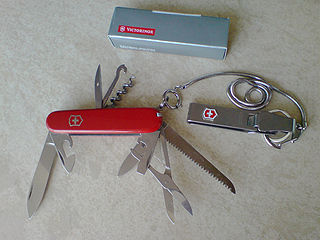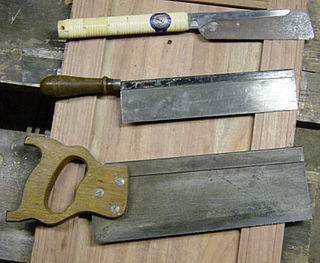
A gimlet is a hand tool for drilling small holes, mainly in wood, without splitting. It was defined in Joseph Gwilt's Architecture (1859) as "a piece of steel of a semi-cylindrical form, hollow on one side, having a cross handle at one end and a worm or screw at the other".

A chisel is a wedged hand tool with a characteristically shaped cutting edge on the end of its blade, for carving or cutting a hard material. The tool can be used by hand, struck with a mallet, or applied with mechanical power. The handle and blade of some types of chisel are made of metal or wood with a sharp edge in it.
In archaeology, a prismatic blade is a long, narrow, specialized stone flake tool with a sharp edge, like a small razor blade. Prismatic blades are flaked from stone cores through pressure flaking or direct percussion. This process results in a very standardized finished tool and waste assemblage. The most famous and most prevalent prismatic blade material is obsidian, as obsidian use was widespread in Mesoamerica, though chert, flint, and chalcedony blades are not uncommon. The term is generally restricted to Mesoamerican archaeology, although some examples are found in the Old World, for example in a Minoan grave in Crete.
A saw is a tool consisting of a tough blade, wire, or chain with a hard toothed edge used to cut through material. Various terms are used to describe toothed and abrasive saws.

Medium-density fibreboard (MDF) is an engineered wood product made by breaking down hardwood or softwood residuals into wood fibre, often in a defibrator, combining it with wax and a resin binder, and forming it into panels by applying high temperature and pressure. MDF is generally denser than plywood. It is made up of separated fibre but can be used as a building material similar in application to plywood. It is stronger and denser than particle board.

The Swiss Army knife is a pocketknife, generally multi-tooled, now manufactured by Victorinox. The term "Swiss Army knife" was coined by American soldiers after World War II because they had trouble pronouncing the German word "Offiziersmesser", meaning "officer’s knife".
A gravity knife is a knife with a blade contained in its handle, which opens its blade through the force of gravity. This mechanism of opening is fundamentally different from the switchblade, which extends its spring-propelled blade automatically upon the push of a button, switch, or fulcrum lever. The main purpose of gravity opening is that it allows opening and closing to be done with one hand, in situations where the other hand is occupied. Hence, historically they have been issued to parachutists to cut off caught lines, such as lines tangled in trees, a major potential use of the gravity knife.
The Laguiole knife is a traditional Occitan pocketknife originally produced in the "knife city" of Thiers, source of 70% of France's cutting tool production, as well as the small village of Laguiole, both located in the Massif Central region of France. Laguiole in this instance does not refer to any knife brand in France, where use of the name is not legally restricted, but to a generic type of traditional slipjoint knife of a sort associated with this French region, now made worldwide.

A drawknife is a traditional woodworking hand tool used to shape wood by removing shavings. It consists of a blade with a handle at each end. The blade is much longer than it is deep. It is pulled or "drawn" toward the user.

A backsaw is any hand saw which has a stiffening rib on the edge opposite the cutting edge, enabling better control and more precise cutting than with other types of saws. Backsaws are normally used in woodworking for precise work, such as cutting dovetails, mitres, or tenons in cabinetry and joinery. Because of the stiffening rib, backsaws are limited in the depth to which they can cut. Backsaws usually have relatively closely spaced teeth, often with little or no set.

A marking knife or striking knife is a woodworking layout tool used for accurately marking workpieces. It is used to cut a visible line, which can then be used to guide a hand saw, chisel or plane when making woodworking joints and other operations. They are generally used when marking across the grain of the wood, with scratch awls better suited for marking with the grain.

A scratch awl is a woodworking layout and point-making tool. It is used to scribe a line to be followed by a hand saw or chisel when making woodworking joints and other operations.

A stitching awl is a tool with which holes can be punctured in a variety of materials, or existing holes can be enlarged. It is also used for sewing heavy materials, such as leather or canvas. It is a thin, tapered metal shaft, coming to a sharp point, either straight or slightly bent. These shafts are often in the form of interchangeable needles. They usually have an eye piercing at the pointed end to aid in drawing thread through holes for the purpose of manual lockstitch sewing, in which case it is also called a sewing awl. Stitching awls are frequently used by shoe repairers and other leatherworkers. Sewing awls are used to make lock stitches. The needle, with the thread in the eye is pushed through the material. The thread is then pulled through the eye to extend it. As the needle is pushed through the material, the extra thread from the first stitch is then threaded through the loops of successive stitches creating a lock stitch. The action is likened to that of a "miniature sewing machine". Styles may vary, as they are adapted to specific trades, such as making shoes or saddles. They are also used in the printing trades to aid in setting movable type and in bookbinding.

Die cutting is the general process of using a die to shear webs of low-strength materials, such as rubber, fibre, foil, cloth, paper, corrugated fibreboard, chipboard, paperboard, plastics, pressure-sensitive adhesive tapes, foam, and sheet metal. In the metalworking and leather industries, the process is known as clicking and the machine may be referred to as a clicking machine. When a dinking die or dinking machine is used, the process is known as dinking. Commonly produced items using this process include gaskets, labels, tokens, corrugated boxes, and envelopes.
A wood scribe is a tool for marking wood by scratching the surface visibly. A wood scribe is often used with a try square for accurate scribing. A marking gauge is a more specific form of wood scribe used to accurately mark wood for cutting, often for laying out mortise and tenon joints.
This glossary of woodworking lists a number of specialized terms and concepts used in woodworking, carpentry, and related disciplines.

An axe is an implement that has been used for millennia to shape, split, and cut wood, to harvest timber, as a weapon, and as a ceremonial or heraldic symbol. The axe has many forms and specialised uses but generally consists of an axe head with a handle, also called a haft or a helve.

Guitar manufacturing is the use of machines, tools, and labor in the production of electric and acoustic guitars. This phrase may be in reference to handcrafting guitars using traditional methods or assembly line production in large quantities using modern methods. Guitar manufacturing can also be broken into several categories such as body manufacturing and neck manufacturing, among others. Guitar manufacturing includes the production of alto, classical, tenor, and bass tuned guitars.

A jigsaw is a reciprocating saw that can cut irregular curves, such as stenciled designs, in wood, metal, or other materials.














